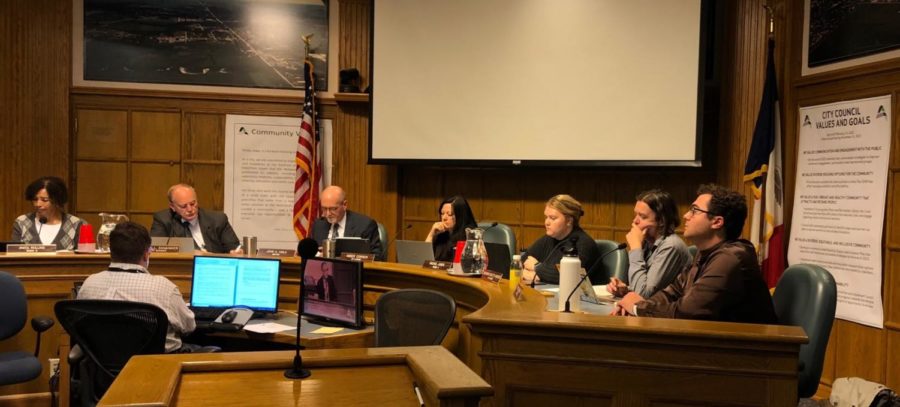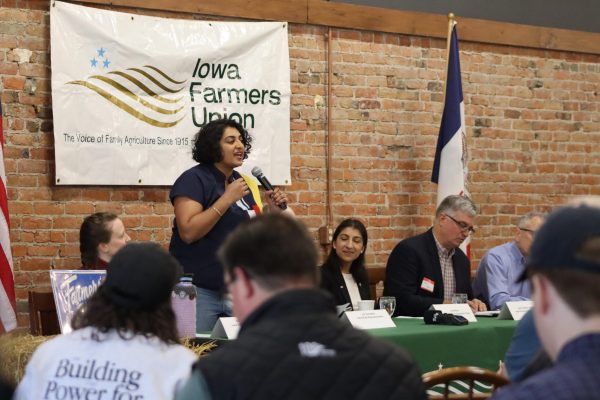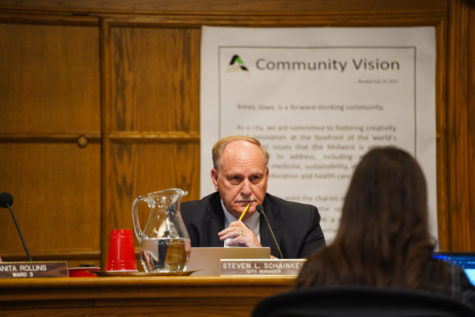The Ames Climate Action Plan and its effect on residents
City council meetings can be viewed on the AmesTelevision YouTube channel.
The Ames City Council is slated to vote on the city’s Climate Action Plan (CAP) Tuesday, and Assistant City Manager Deb Schildroth says the city plans to keep costs low in whatever plan the council may proceed with.
What is the Ames CAP?
In April 2021, the Ames City Council contracted Sustainable Solutions Group (SSG), a Canadian climate planning organization, to carry out research and put together a plan for lowering Ames’ carbon footprint.
Earlier this year, SSG presented a draft of the Ames Climate Action Plan to the Ames City Council. The goals of the CAP have been dynamic over the past two years of planning, but the latest draft has Ames reducing their carbon output 71% by 2030 and 94% by 2050.
According to previous reporting by the Daily, City Manager Steve Schainker said the council is not committing to everything in this plan if it is approved.
“[The consultants] laid out in the report that every year we have to come up and [the council] has to approve an annual action plan, and that’s where you’ll start getting the expenditures and which programs you want,” Schainker said.
Ames community members can reach out to the team working on the CAP at [email protected] to share their thoughts and concerns.
Why should Ames reduce carbon output?
The Fourth National Climate Assessment from the U.S. Global Change Research Program highlights potential risks all across the nation.
“Climate change is expected to worsen existing health conditions and introduce new health threats,” the assessment states. “By mid-century, the region is projected to experience substantial, yet avoidable, loss of life, worsened health conditions, and economic impacts estimated in the billions of dollars as a result of these changes.”
According to the assessment, these impacts would take the form of increasingly frequent and intense poor air quality days, extreme heat waves and heavy rainfalls.
According to an analysis completed by a city-hired consultant paleBLUEdot, an environmental protection consulting company, 26.8% of Ames residents are estimated to be under economic stress, defined as being 200% below the poverty line. These residents also make up 44% of what paleBLUEdot describes as climate vulnerable people in Ames.
PaleBLUEdot also reports that the two largest groups living below the poverty line in Ames are males 18 to 24, which make up over 40%, and females 18 to 24, which make up around 35%.
SSG says the CAP represents an opportunity to prepare for these impending effects of climate change. Through the plan, these preparations take the form of shifting away from fossil-fuel-based infrastructure as its availability becomes more volatile and the benefits of energy-efficient homes during heat waves become apparent.
What are the steps of the CAP?
The CAP is broken down into “six big moves”:
- New net-zero constructions
- Building retrofits
- Reducing vehicle emissions
- Reducing waste emissions
- Renewable energy
- Increasing active and transit transportation use
These six goals are further broken down into a seven-step implementation process:
- Increasing wind and solar
- Waste to energy improvements to help reduce waste emissions
- Policies to support net-zero construction
- Implementing a pilot program to incentivize retrofits in older homes
- Hiring a consultant to help plan retrofits for municipal buildings
- Create a Mayor’s CAP Leadership Task Force
Renewable energy generation and building retrofits are the two steps that are projected to reduce greenhouse gas emissions the most.
Donald Kom, Ames Director of Electric, called the plan a “pivotal moment in utility history.”
What would renewable energy mean and what’s the goal?
In November 2022, the council met with SSG to discuss an analysis of the CAP by Ames city staff. During this meeting, SSG model analyst Erik Frenette stated that electricity costs could be expected to go down.
According to minutes from the meeting, Frenette expects the average household will save $170 to $220 in annual electric savings.
The current CAP has Ames constructing a 50 megawatt (MW) solar farm that residents would be able to interact with through power purchasing agreements which allow a customer to buy the electricity produced by the solar farm without owning the solar panels themselves.
Currently, Ames has a solar farm following this model called SunSmart, which is a 2 MW solar farm that the Ames Electric Department owns and operates.
“Anybody that has an electric bill can buy a power pack and then we maintain the entire farm,” Kom said. “We don’t identify your panel, but you get a percentage of the energy that comes off the farm. These power packs can be bought for yourself or donated to somebody else.”
Kom said that in his personal experience, three power packs would equal about $3 to $5 saved a month.
SSG’s presentation April 18 had a 50 MW farm being constructed by 2025, which would come from the IRA.
What do retrofits mean and what are the goals?
In the proposal, building retrofits are renovations done to improve the energy efficiency of that building. This could range from better insulation to installing geothermal pumps for heating and cooling.
In the CAP, 90% of residential buildings built before 1981 would be retrofitted by 2030 and 90% of newer residential buildings would be retrofitted by 2040. The standard for these retrofits would be 60% in thermal savings and 15% in energy savings.
The plan also suggests adding air-source heat pumps and electric water heating systems to all buildings by 2040.
According to Ames Public Relations Officer Susan Gwiasda, during a city council workshop introducing the plan Kom said that due to how heat pumps and solar panels function, Ames utility rates could peak in winter months instead of the summer.
What is the Pilot Program?
One of the incentive programs is a pilot program suggested by city staff in November 2022, which would offer to pay for part or all of retrofit installation costs depending on the household income.
Ames Assistant City Manager Deb Schildroth said these programs would start in older neighborhoods because they are more susceptible to climate change and are generally owned by low-income families.
According to Gwiasda, the city has started a fund within the city budget that would go toward these initiatives and programs, but the program has not been approved. Through the pilot program, low-income residents in Ames will be able to afford some changes the city could implement through the CAP.
Will Ames receive IRA funding?
Decarbonization and getting Ames closer to net-zero greenhouse gas emissions are expensive goals, as paying for the entire plan would cost $3.2 billion. In the April 18 presentation to the council, SSG said Ames could receive $770 million from the Inflation Reduction Act (IRA).
According to the Roosevelt Institute, a think tank focusing on economic equality, the IRA is a landmark investment into fighting inflation as well as climate change among a number of social issues and offers tax credits and rebates to citizens and local municipalities.
Ward 2 Rep. Tim Gartin voiced concern about Ames being awarded all of the estimated $770 million at the April 18 presentation.
“This is not going to be distributed in a nice even fashion,” Gartin said. “When you look at other federal programs that have [been] distributed, Iowa is one of the lowest states in terms of recipients for government programs.”
According to the United States Department of Treasury, Iowa ranks 35th in terms of federal funding and received 0.69% of all funding awarded to states and territories in the past 12 months. In that time, Iowa has been awarded $29 billion and $6.3 million of that went to Story County, around 2.1%.
At the April 18 meeting, Yuill Herbert, the director of SSG, said that Ames could expect more funding because it is the first municipality to incorporate IRA tax credits into its climate action plan.
In an interview with the Daily, Gwiasda said that they were picking apart the IRA to find anything that could help.
“We are working with other groups that are trying to understand the IRA,” Gwiasda said. “The IRA is huge […] so we’re reaching out to other organizations and other communities to find out how they feel that they can best take advantage of these opportunities.”
Gwiasda says that city staff are also looking at all kinds of funds and grants to help make every part of the CAP a reality.
How are renewable energy and retrofits going to impact levy and utility rates?
If Ames isn’t awarded enough tax credits, an analysis done by the city on the CAP suggests a raise in utility rates in order to help pay for this solar farm.
In an interview with the Daily, Kom explained why switching to renewable energy could come with some higher utility rates.
“I have to basically borrow or bond $100 million, which is going to create this payment stream over the next 20 years, to pay for that,” Kom said.
Kom said the pay stream refers to increasing utility rates and added that he is “trying to do everything” he can do to keep rate increases “as minimal as possible.”
Schildroth said that whatever utility increase comes in the future will come gradually.
“We don’t want Ames to be so expensive that no one wants to live here,” Schildroth said.
One possible strategy outlined in an analysis done by the city is to fund incentives by raising the general levy.
The report describes a possible $8.10 raise to the general levy which would generate an additional $8.9 million annually and result in a 26% increase in property taxes.
“The city could also consider funding the total retrofit action step with utility-backed revenue bonds,” the report stated. “However, the electric utility rate increase required to repay the bonds is projected to be 356%. Low and middle-income residents would be significantly impacted by the rate increases required to fund the retrofit project.”
How can you participate?
Ultimately, reducing emissions is a community effort. SSG warns that the cost of doing nothing, while harder to see, would be much higher than what the CAP asks for.
According to the U.S. Census Bureau, 56.6% of occupied housing units in Ames are occupied by renters and thus would not have the ability to make renovations. Despite this, Gwiasda says there are some things renters can do.
“Forget the climate action plan—it’s going to go down its path,” Gwiasda said. “What can people do today if they’re concerned about increasing costs? We do a lot of outreach about how you can reduce your electric bill and how you can reduce your water bill. Did you know you can call Ames Municipal Utilities and ask for the utility bill if you’re comparing two different units?”
Gwiasda said reaching out to your landlord could convince them that some changes are worth the cost and also recommends looking for apartments that have already made energy efficiency improvements.
Currently, Ames residents can qualify for rebates on utilities through electric vehicles or lawnmowers, certain types of in-window air conditioners and other energy-efficient investments.
Check these websites below to find out more:
Ames residential rebate programs: Residential Programs | City of Ames, IA
Emailing council: [email protected]
Your donation will support the student journalists of the Iowa State Daily. Your contribution will allow us to purchase equipment, send our student journalists to conferences and off-set their cost of living so they can continue to do best-in-the-nation work at the Iowa State Daily.

















